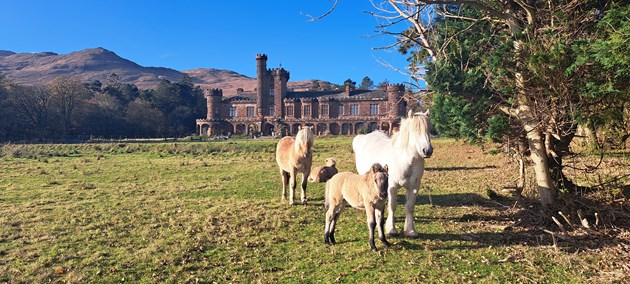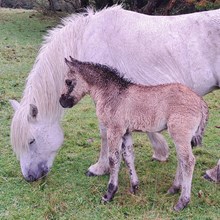28 December, 2023
Rum National Nature Reserve welcomes newest residents

Rum National Nature Reserve (NNR) welcomed some new residents this year with the arrival of two rare Highland pony foals.
The foals, named Fhuarain and Shellesder, are settling in well to their island home where NatureScot maintains a herd of around 20 ponies.
The translation of the Gaelic Fhuarain means spring or burn, while Shellesder means Iris. Both are the names of glens on Rum.
The Rum ponies are a special island type of hardy Highland pony with ancient bloodlines. The first written record of Highland ponies on Rum dates back to 1778.
The ponies play an essential role in deer management on the NNR, helping to carry out deer carcasses from remote areas to be processed and sold for venison. They are also carefully bred and managed on the island to ensure the long-term survival of this rare breed.
NatureScot’s Rum NNR manager Lesley Watt said: “We are delighted to welcome two new Highland pony foals to the island this year as part of our long-term breeding programme which aims to preserve the ancient, rare bloodlines of Rum’s ponies.
“One of our Rum Highland ponies Soay produced a colt foal in the summer that we have named Fhuarain while another pony Minishal produced a filly foal in September that we have named Shellesder.
“Both of the foals are settling in well and will eventually join the rest of the herd helping with the deer management work on the reserve. Visitors and locals alike can look out for these much-loved residents as they roam freely about the island, most often to be spotted at Harris or Kilmory.”
The ponies are not the only animals helping with conservation on the NNR. Rum is also home to a herd of 11 Highland cattle that help maintain and improve protected grassland habitats on the island that require a delicate balance of grazing.
As large herbivores, the cattle have an important role in grazing back summer growth and breaking up the ground to create controlled disturbance.
The cattle are also used to graze areas that are dominated by purple moor grass to increase species diversity and encourage restoration of dwarf shrub heath habitats. This will also help to reduce the high fuel load of dead purple moor grass leaves and improve resilience to wildfires.
Elsewhere on the island, it was a good year for the breeding colony of Manx shearwater - one of the largest in the world. In 2023, 75% of monitored burrows produced a chick, which is above the long-term average for this long-lived species that only lays a single egg each year.
Rum NNR’s visitor centre also underwent a major overhaul this year. Visitors can enjoy a newly designed centre packed with information about the island’s habitats and species, thanks to a team of volunteers led by Eva Kohle.
ENDS
Contact information
- Name
- NatureScot Media
- Telephone
- 0131 316 2655
- media@nature.scot
Notes to editors
Find out more about Rum National Nature Reserve.
There are 43 National Nature Reserves in Scotland. These are special places that look after some of the best of Scotland’s nature on behalf of everyone who lives or visits Scotland, and they provide unique opportunities to visit, enjoy and learn more about Scotland’s nature. For more information, see see www.nnr.scot.
NatureScot is Scotland's nature agency. We work to enhance our natural environment in Scotland and inspire everyone to care more about it. Our priority is a nature-rich future for Scotland and an effective response to the climate emergency. For more information, visit our website at www.nature.scot or follow us on X at https://x.com/NatureScot
’S e NatureScot buidheann nàdair na h-Alba. Bidh sinn a’ neartachadh àrainneachd na h-Alba agus a’ brosnachadh dhaoine gu barrachd suim a chur ann an nàdar. Tha e mar phrìomhachas againn gum bi nàdar na h-Alba beairteach agus gun dèilig sinn gu h-èifeachdach le èiginn na gnàth-shìde. Tha an tuilleadh fiosrachaidh aig www.nature.scot no air X aig https://x.com/NatureScot



